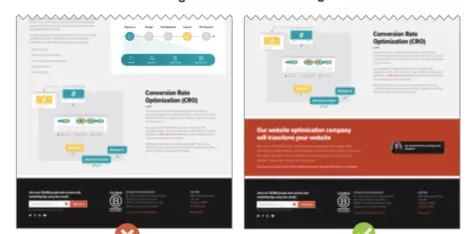Visitors are judging you from the moment they enter your site. You got them there with a witty link on twitter or relevant information in a google search. You are rocking your content marketing. (Andy would be proud).
But now what?
People expect more these days. Content may be king, but design is queen. (A mighty lovely one if you ask me).
Apple. Target. Starbucks. The public is fed an increasingly consistent diet of well designed products, services, and experiences. The web is no longer just a tool for amateur techies and high school nerds.
Just like people expect better content, they expect better design.
Good design is becoming a necessity and is no longer something that is reserved for companies with multimillion dollar budgets. It is something that every company and person with a website needs to think about. If you spent the money to have your site designed and built, you owe it to that investment to maintain your visual identity.
If you can faithfully avoid these seven sins, your site will maintain its polished, newly launched panache.
1. Inconsistency
This is the first sin of maintaining a brand image is to break with an established style. I have written before about maintaining  a visual language, but I am going to repeat it again. Be consistent. Use the font styles in your brand guide or web style guide. Stick to brand colors. Maintain a style.
a visual language, but I am going to repeat it again. Be consistent. Use the font styles in your brand guide or web style guide. Stick to brand colors. Maintain a style.
Pro-tip: In the WISIWYG editor of most content management systems, there are predefined styles to choose from. By using these you will know that your type is consistently styled.
2. Lack of Quality
It pains me when I see companies and bloggers commit this sin. And, sure, I am sensitive to it because I am in the industry, and I know how good images can look. But this is probably the easiest to avoid.
Choose images that are in focus (or if they are blurry, make sure it is obvious that was the intention). They should be at least as large as the space you wish to use them in, preferably larger so you can crop the part of the image you like best. Enlarging an image for use on the web almost never looks good, so just don’t do it.
preferably larger so you can crop the part of the image you like best. Enlarging an image for use on the web almost never looks good, so just don’t do it.
A few other things to avoid: Photos that are grainy, photos with a yellow cast from incandescent light, and pictures with a harsh flash.
Pro-tip: If it is a blog post, use some candid photos you took with your phone or at a company event. Is it your homepage? Invest a few bucks and buy a large version of the image you want. The difference will show.
3. Incongruity
Your images and marketing messages have to line up. Does an iceberg make sense as an image on a dermatology website? A  handshake photo on a swimwear site?
handshake photo on a swimwear site?
Just because an image is cool or attention grabbing doesn’t mean it works for your site. Images should support your content and not just be something you stick in because I told you to put them in.
Pro-tip: An image that would normally seem out of place can work, and be effective, but only if you relate what is happening in the image directly to your content.
4. Complexity
I am sure you have seen (or heard) the acronym, KISS (Keep it Simple, Stupid). There is very, very good reason for it. You don’t  want to overwhelm your visitors with too much information at once. Adding text, bursts, or speech bubbles to images can overly complicate what the visitor is looking at.
want to overwhelm your visitors with too much information at once. Adding text, bursts, or speech bubbles to images can overly complicate what the visitor is looking at.
Pro-tip: By keeping your design and imagery simple, call-to-actions such as buttons, links, and subscription boxes stand out, increasing the likelihood that a visitor will convert.
5. Leaving Out Images
There is almost nothing worse than a web page with no pictures. Ok, fine, sometimes there isn’t a need. But if your whole website is just text, then you are missing out on a great opportunity to reinforce your content. Images add visual interest to the  page and add another way for you to present your message to your visitor.
page and add another way for you to present your message to your visitor.
Pro-tip: You can repeat images on your site, but only if it makes sense. Aligning an image with a top-level navigation item and using it with that item’s subpages is an easy way to add images to pages without having to invest in a large stock photo library.
6. Generic Images
Not images of people crossing the street, but images that everyone uses. That photo of a smiling customer service agent with a headset and great hair? Just don’t go there. It doesn’t make your company look bigger. Or more trustworthy. It shows that you and 10,000 other companies are thinking the same way.
What’s worse? Customers might assume that you are hiding  something. Are you outsourcing your customer service to a foreign country? Is it one guy in a basement who can barely keep up? Is there really anyone there?
something. Are you outsourcing your customer service to a foreign country? Is it one guy in a basement who can barely keep up? Is there really anyone there?
Pro-tip: If you have one customer service employee, and his name is Bob, use his picture and real first name (Abt does this well). Or, if you do have a smiling customer service lady of your own, take her picture. Have a group? Take a group photo and write a blog post about their talent. Maybe you want to highlight your whole team. Just don’t use that one lady that everyone uses. Please.
7. Rigidity
I know I keep saying that consistency is key, but a refusal to evolve is almost as deadly for a brand. Take Starbucks for example, their logo has changed consistently over their history, but the logo they have today would still be recognized by their original  customers.
customers.
By continuing to evolve, their logo has stayed fresh and current. So, don’t be afraid to evolve your style.
Pro-tip: Regular maintenance and small design updates can help to keep your website fresh and up-to-date. No one likes a website that is showing its age.
What are you doing to avoid committing these sins?



